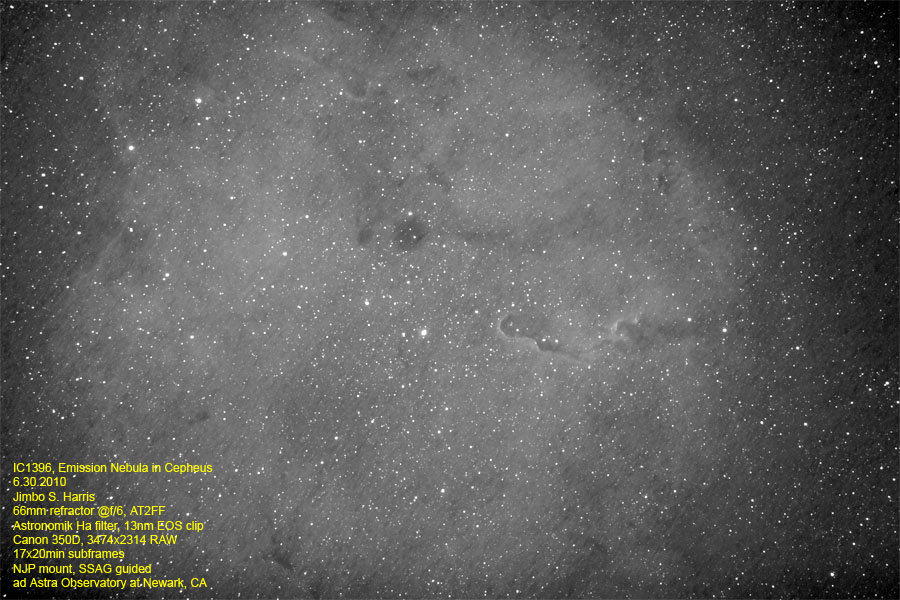Sometimes you luck out when you’re “just testing”. I am still shaking out the kinks in my 350D workflow. I put the Ha filter back on the 350D last night. Focusing with my new commercially-produced Bahtinov mask was a snap. Those spikes were seriously sharp.
I thrashed around a little on what to shoot and &c, ended up doing some 20m subframes of IC1396. When I woke up in the morning, the sun was up and I lost 3 frames. But I ended up with 17 lights that are usable. Because it’s a new camera, I didn’t have any 20m darks yet, so I set it to shooting a bunch of 20m and 10m darks, which took all day.
I still need to shoot some flats, but I’ll get around to that.
One thing I have found is that I seriously need to clean the CCD. There is a dust bunny on there that is like 150 pixels across. You can clearly see it on the first-light NGC7000 photo, and I haven’t cleaned my optics yet.
The dew heater ran all night on a separate power supply form the rest of the rig. The scope was without dew this morning, but the finders (which had no dew prevention) were also not dewed up, so I don’t know that this is the best indicator of anything in particular.
One thing that I’ve definitely noticed is that I am having the same irritating thing happen with my FOV now that I had when I switched from film to CCD.
Right about the time I switched from film to CCD, I owned a ED80 refractor (600mm f.l.), then I bought a Meade SN6 (750mm f.l.). The SN was f/5 to the refractor’s f/7.5, but the additional f.l. meant that the FOV was ever-so-slightly smaller. Then I switched to CCD. 35mm film is 36x24mm. DSLRs use an “APS” size sensor, 23x15mm. So again, my FOV got compressed. And all of a sudden, instead of being able to just barely squeeze NGC7000 into the FOV of the film camera/ED80, there was absolutely no chance with the DSLR.
So I bided my time, waited for a nice 400mm ED refractor to come out, and finally picked up Pumpkin a couple years later. A few nights out with Pumpkin revealed that the field was badly curved, so I picked up the only field flattener available at the time, the William Optics 0.8x FR/FF, which turned the scope from a 400mm f/6 into a 320mm f/4.8. The difference in exposure length isn’t really noticeable. But the FOV was gigantic. It’s like twice the size of the FOV I got with the ED80. So I was happily ripping down these huge swathes of sky.
Then I made two critical decisions.
First, I decided that I wanted the field flat but not focal-reduced, so I picked up an Astro-Tech FF.
Second, I got an offer I couldn’t refuse on a 8mpx DSLR, so in comes the 350D.
So, now Pumpkin gets a ever-so-slightly smaller FOV with the new flattener, and the 350D (being more pixels on the same size sensor) gets an ever-so-slightly smaller FOV still. The difference seems small when considering the whole FOV: 4°x2° -> 3.2°x2.2°. But when you consider that a 1000px x 1000px crop out of the 300D/0.8x FR combo covers an area 78′ square, but the same crop out of the 350D/FF combo covers an area 55′ square, it’s big. The 350D’s square covers half the amount of sky (in area) the 300D’s square does. Whoa.
And it shows. Big objects that used to flop around in the middle of the frame with plenty of space around the edges now barely fit. And the stuff that used to barely fit, no longer fits at all. It’s a brave new world.
So this is how much of IC1396 I captured. It was spilling off the sides of the frame when I shot it last year.
I need to go grab some Veil, too, and see what’s what.
…and I may go back and buy a WO 0.8x again, as much as it pains me. sigh.
I’m still tweaking and tuning.
Here’s the image, 17x20m subframes, 5h 40m, in Ha from the observatory.


MOST COMMENTED
Observatory
Observatory 2.0 – Time has come today!
General / Maintenance
First Light, a deeper look
Mount / Observatory / Telescope
Observatory 2.0 – Result!
Observatory
Observatory 2.0 – The Pier goes in
Gear / General / Maintenance
Martin Farmer Wormblock installation notes
Deep Sky / Long Exposure Photography
NGC2244, The Rosette Nebula
Deep Sky / Long Exposure Photography
Another beautiful night.